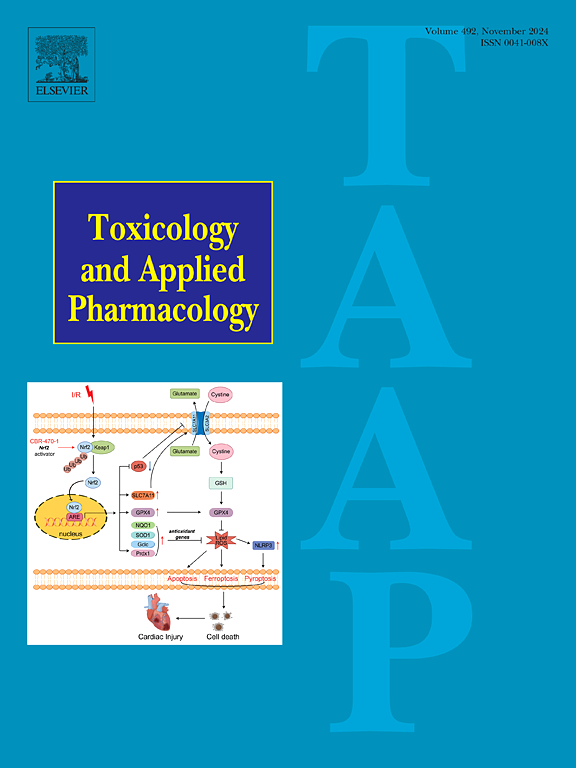富cbd大麻提取物在大鼠亚慢性变性研究中的安全性评价。
IF 3.3
3区 医学
Q2 PHARMACOLOGY & PHARMACY
引用次数: 0
摘要
大麻二酚(Cannabidiol, CBD)是一种来自大麻的植物大麻素,目前人们对大麻的药用兴趣日益浓厚。在这里,我们重点研究了一种富含cbd(77 %,w/w)的全谱大麻提取物在雄性和雌性大鼠中的安全性和药代动力学。以0.5、5、10和35 mg CBD提取物/kg/天经胃给药进行90天亚慢性毒性试验。未观察到器官或体重、行为、运动、食物摄入或发病率/死亡率的不良反应或破坏。病理形态学检查未见胃肠道或肝脏改变。血液细胞分析显示显著(p 2+,Na+, K+和Cl-),碱性磷酸酶和肌酐在治疗动物中也观察到两性。雄性表现为谷丙转氨酶水平降低,雌性表现为高白蛋白血症(p本文章由计算机程序翻译,如有差异,请以英文原文为准。
Safety assessment on CBD-rich hemp extract in sub-chronic cross-sex study with rats
Cannabidiol (CBD) is a phytocannabinoid from Cannabis sativa L., in which there is currently growing interest for medicinal use. Here, we focused on the safety and pharmacokinetics of a CBD-rich (77 %, w/w) full-spectrum hemp extract in male and female rats. A 90-day sub-chronic toxicity assay was conducted with doses of 0.5, 5, 10, and 35 mg CBD extract/kg/day administered orogastrically. No adverse effects or disruption in organ or body weight, behaviour, locomotion, food intake, or impact on morbidity/mortality were observed. Pathomorphological examination showed no gastrointestinal or liver changes. Blood cell analysis showed a significant (p < 0.05) decrease in the number of leukocytes for both sexes, and a significant difference (p < 0.01 or 0.05) between the control and treated animals for mean corpuscular haemoglobin concentration, mean corpuscular volume of erythrocytes, and percentage of neutrophils and monocytes. However, blood cell analysis revealed significant (p < 0.05) sex-dependent differences, such as haematocrit and erythrocyte count. The levels of ions (Ca2+, Na+, K+ and Cl−), alkaline phosphatase activity, and creatinine level in treated animals were also observed for both sexes. Males exhibited decreased alanine transaminase activities, and females exhibited hyperalbuminemia (p < 0.01). CBD was quantified in treated animals in a dose-dependent manner, with statistical significance varying from p < 0.05 to 0.0001. The accumulation of CBD in the individual tissues increased in the order: brain < serum < liver < heart << kidney <<< muscle and skin. The results indicated sex-dependent latent disruption of kidney and liver homeostasis, most likely reversible in nature.
求助全文
通过发布文献求助,成功后即可免费获取论文全文。
去求助
来源期刊
CiteScore
6.80
自引率
2.60%
发文量
309
审稿时长
32 days
期刊介绍:
Toxicology and Applied Pharmacology publishes original scientific research of relevance to animals or humans pertaining to the action of chemicals, drugs, or chemically-defined natural products.
Regular articles address mechanistic approaches to physiological, pharmacologic, biochemical, cellular, or molecular understanding of toxicologic/pathologic lesions and to methods used to describe these responses. Safety Science articles address outstanding state-of-the-art preclinical and human translational characterization of drug and chemical safety employing cutting-edge science. Highly significant Regulatory Safety Science articles will also be considered in this category. Papers concerned with alternatives to the use of experimental animals are encouraged.
Short articles report on high impact studies of broad interest to readers of TAAP that would benefit from rapid publication. These articles should contain no more than a combined total of four figures and tables. Authors should include in their cover letter the justification for consideration of their manuscript as a short article.

 求助内容:
求助内容: 应助结果提醒方式:
应助结果提醒方式:


